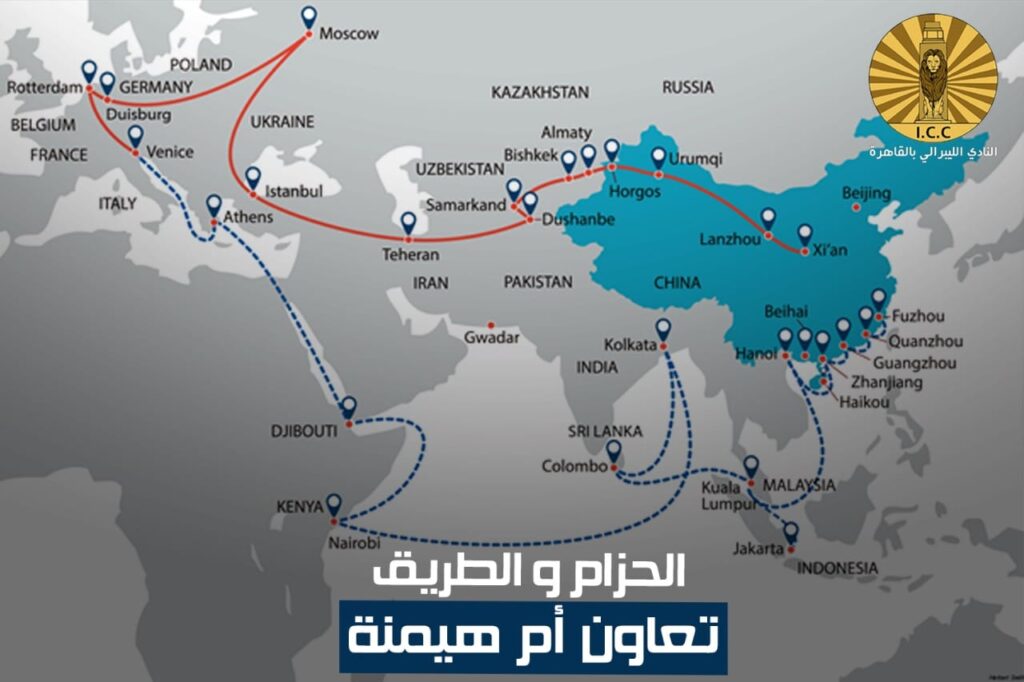In 2013, during the visit of Chinese President Xi Jinping to both Kazakhstan and India, he announced his vision to revive the ancient Silk Road, which was the main corridor for trade between Asia and Europe. The Chinese leader’s vision was quickly crystallized for a giant global initiative under the name (One Road, One Belt). Then It was renamed to be called (the Belt and Road Initiative) to avoid the negative impact of the previous name, which clearly reflects that the Chinese approach is within the framework of a unilateral proactive strategy to reshape the global system and its balances in a way that maximizes China’s role in it, so that China turns into a major pivotal player in the new world order. Then the name was later changed to indicate the universality of the strategy and its sharing with various international parties.
The initiative consists of two main paths: the first is the Belt, which is a land link between China and Europe, interspersed with several subsidiary corridors, and the second is the road, which is a sea route linking China with Europe and Africa. The cost of the investments necessary for this connection through cross-country infrastructure projects in the countries included in the initiative is estimated at one trillion dollars. The initiative includes about 69 countries in Asia, Europe and Africa, and the magnitude of this initiative is such that it covers approximately 43% of the Earth’s area and covers more than half of the planet’s population.
But what the Chinese President launched was not an initiative in its scientific sense, but rather a strategy with origins dating back to the year 2012, when the Chinese President at the time, Hu Jintao, announced at the Eighth National Congress of the Communist Party of China China’s aspiration to be a major maritime power, which was later translated into issued policy papers. The Chinese Navy has transformed its role so that it can be a defense force and protect Chinese interests in open waters and can carry out tasks that reflect its strength in the high seas and oceans.
Since China depends on sea routes to pass 90% of its trade volume and 60% of its value, therefore, China had to have a strategy to strengthen its maritime presence and expand the scope of its trade, in addition to China’s reliance on importing energy from abroad, which the Chinese government believes that relying on external energy sources is… A weak point: The initiative will contribute to securing China’s growing energy needs in the coming decades, through the “going abroad” strategy, which means China pumping foreign investments into the energy sectors.
It is worth noting that about 40% of Chinese foreign investments during the past decade were directed to the energy sector. To achieve a maritime military presence, China requires many ports along the main shipping lines. This is what Zhang Jie, a researcher at the Chinese Academy of Social Sciences, mentioned in an article issued in 2015 about the concept of (civilian first, military later), which means the possibility of slowly converting civilian ports that receive military pieces and preparing them for that purpose to transform into strategic support points for the Chinese Navy to carry out its tasks. The Belt and Road Initiative is divided. It has two main parts: the navigational road and its multiple paths, and the belt, which is the land road with its various axes and paths. Looking at the navigational paths, we find that China, in line with its orientation to be an influential maritime military power and the principle of (civilian first, military later), China has undertaken, through companies and government financing institutions, a long series of acquisitions. Investment in seaports from the Indian Ocean to the North Sea reached 42 ports in 34 countries. We mention here the ports that China has acquired or that have a controlling stake along the way.
Kayukpyu port in Myanmar
Hambantota Port in Sri Lanka
. Gwadar port in Pakistan
Vidhoo Finolhu Port in Maldives
Muara Port in Brunei
Malacca Gateway Port in Malaysia
Kuantan port in Malaysia
. Port of Darwin, Australia
Obokok port in Djibouti
. Piraeus port in Greece
. Port of Valencia in Spain
Ambarli Port in Türkiye
In addition to contracts for the development and management of ports in Israel, China will finish building the southern port of Ashdod in 2021, which is the same year in which it begins managing the port of Haifa for a period of 25 years, in addition to the ongoing discussions with the Italian side regarding the port of Palermo. In general, according to statements by the Chinese Ministry of Transport, China has established and managed 52 ports in 34 countries around the world. China has embarked on the second phase of the strategy, after inaugurating its first military base outside the country in 2017 in Djibouti, in which China owns the lion’s share of foreign debt. It owns and operates sea ports. In the following year, 2018, China deepened and developed the base’s navigational dock to accommodate large military ships. Thus, we see that what is being marketed through official Chinese channels as the Belt and Road Initiative, which is based on peace, cooperation, mutual benefit, and win-win, is in reality. It is a Chinese strategy to dominate international trade routes and establish Chinese military control over them.


